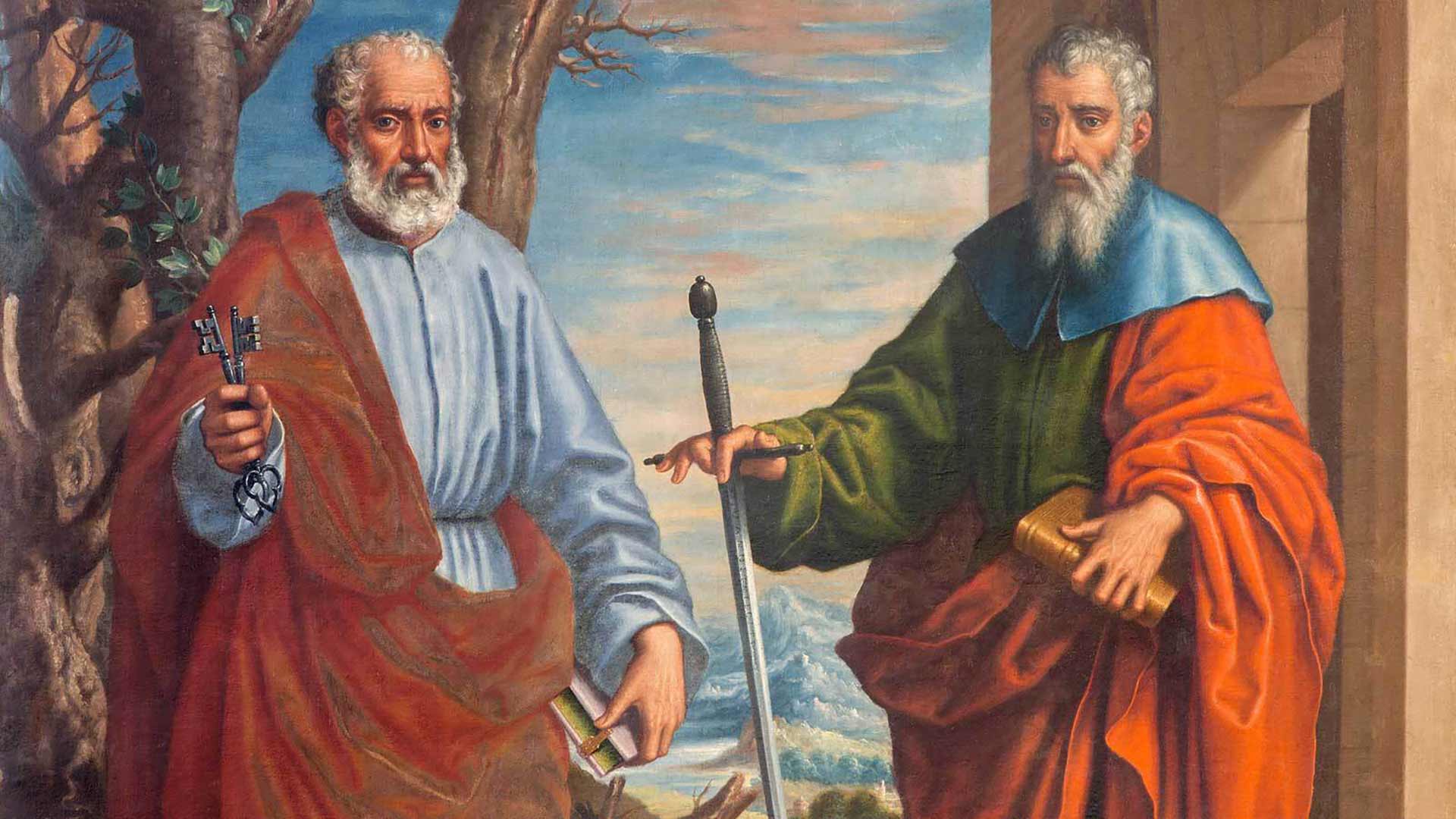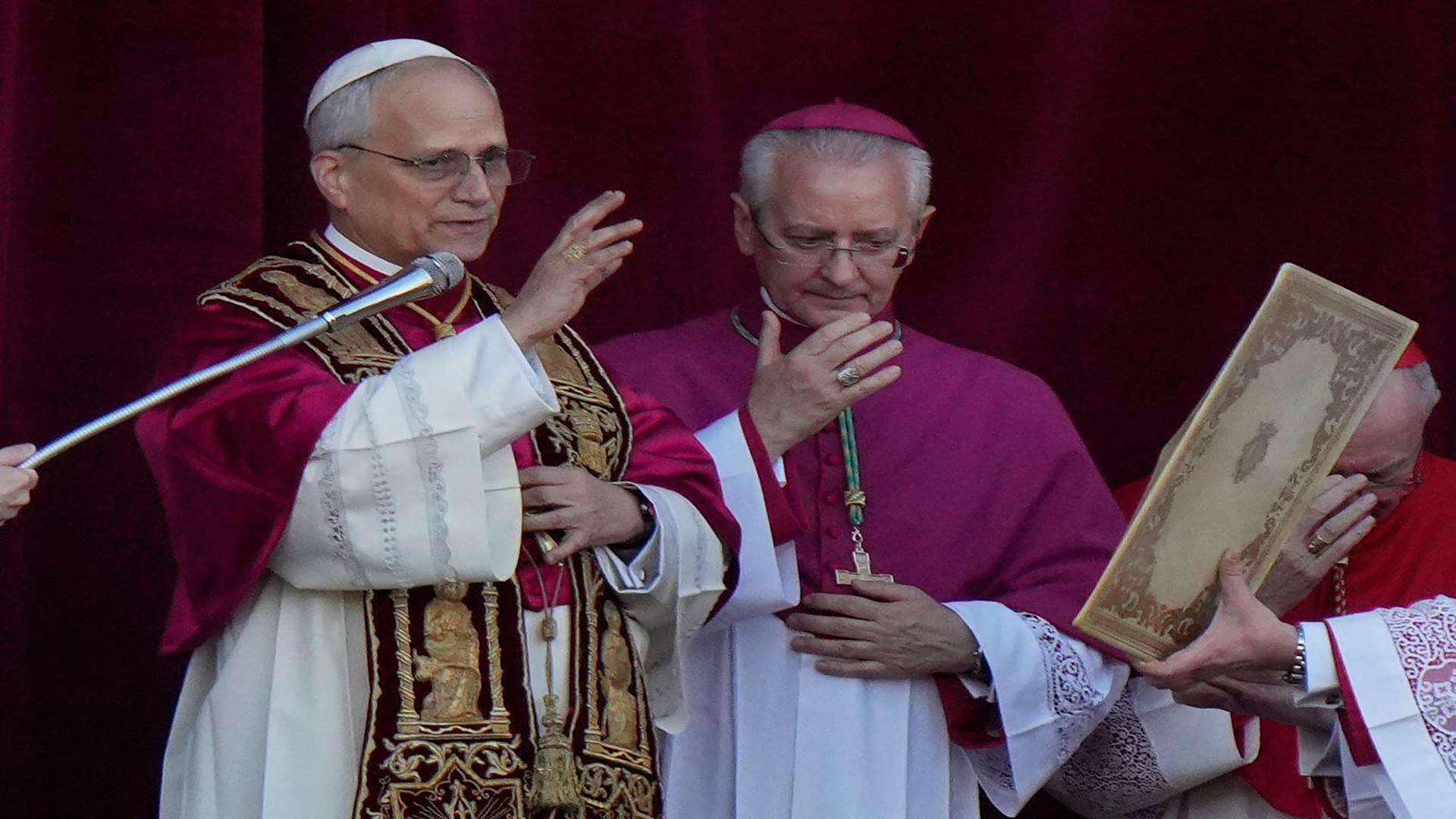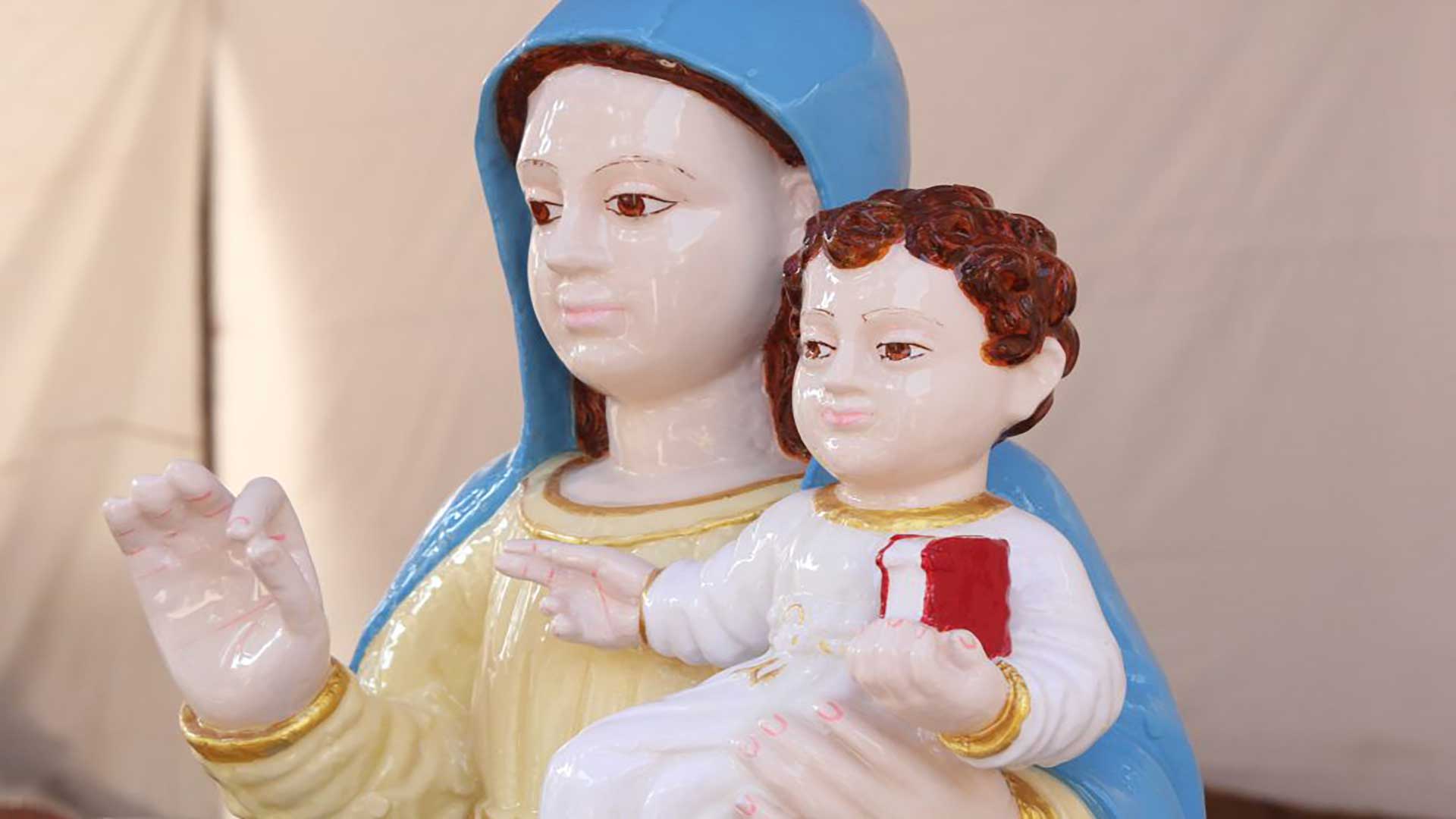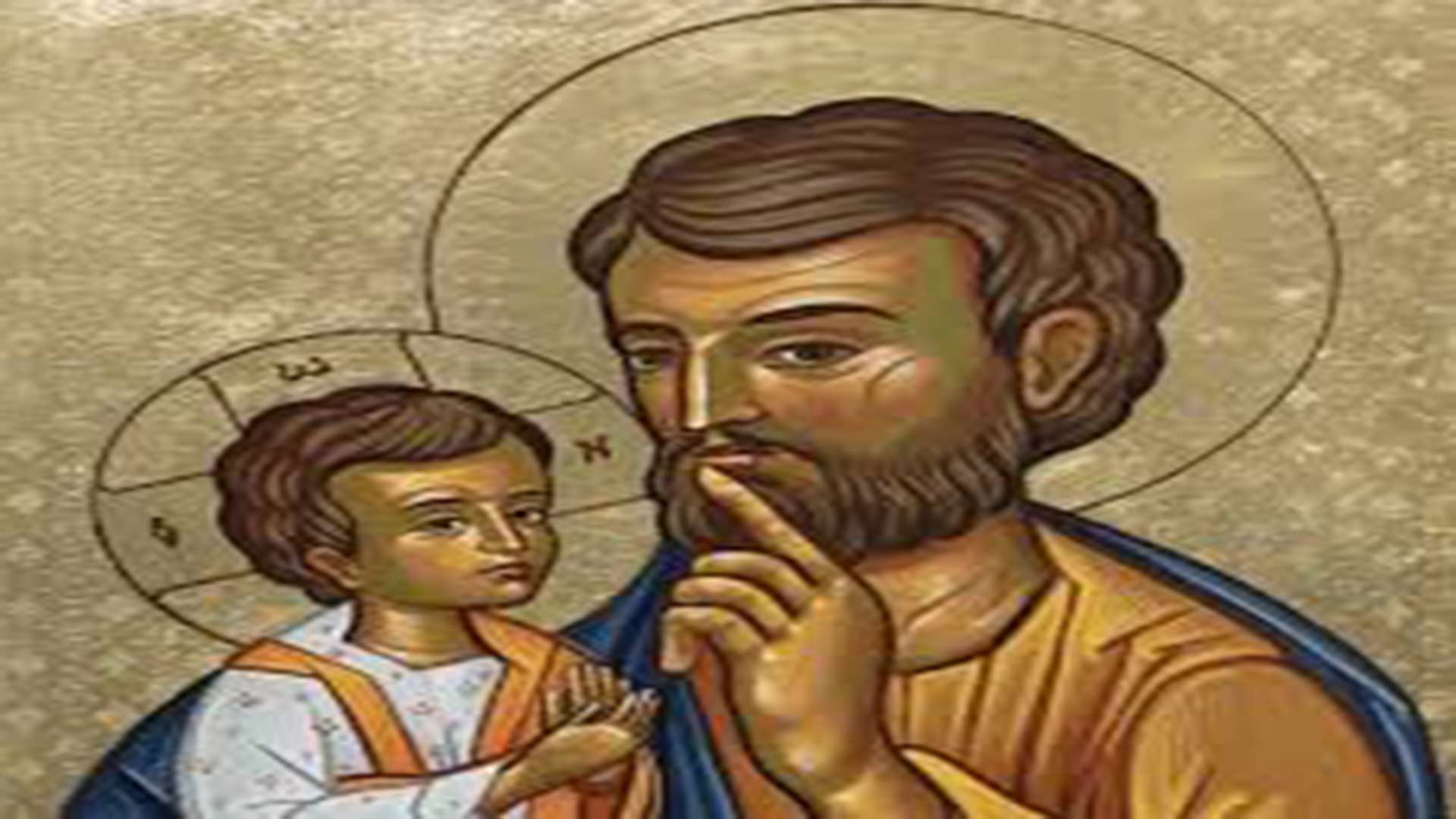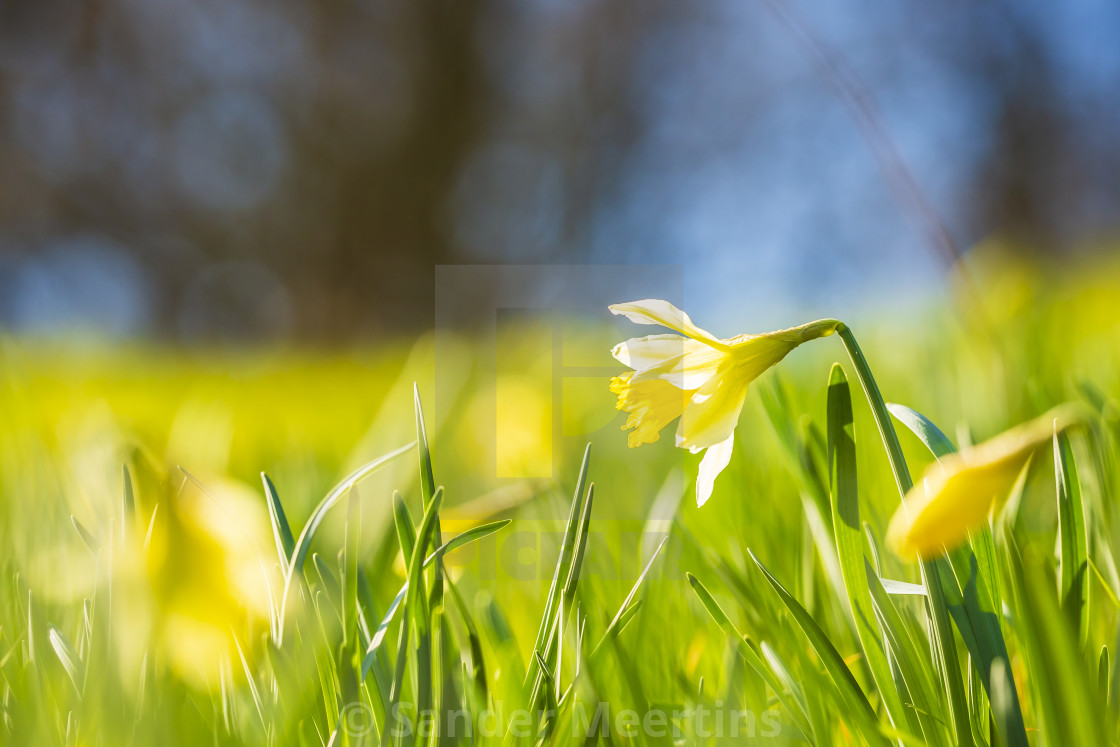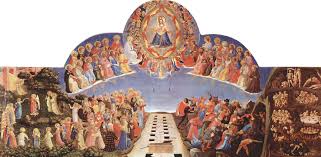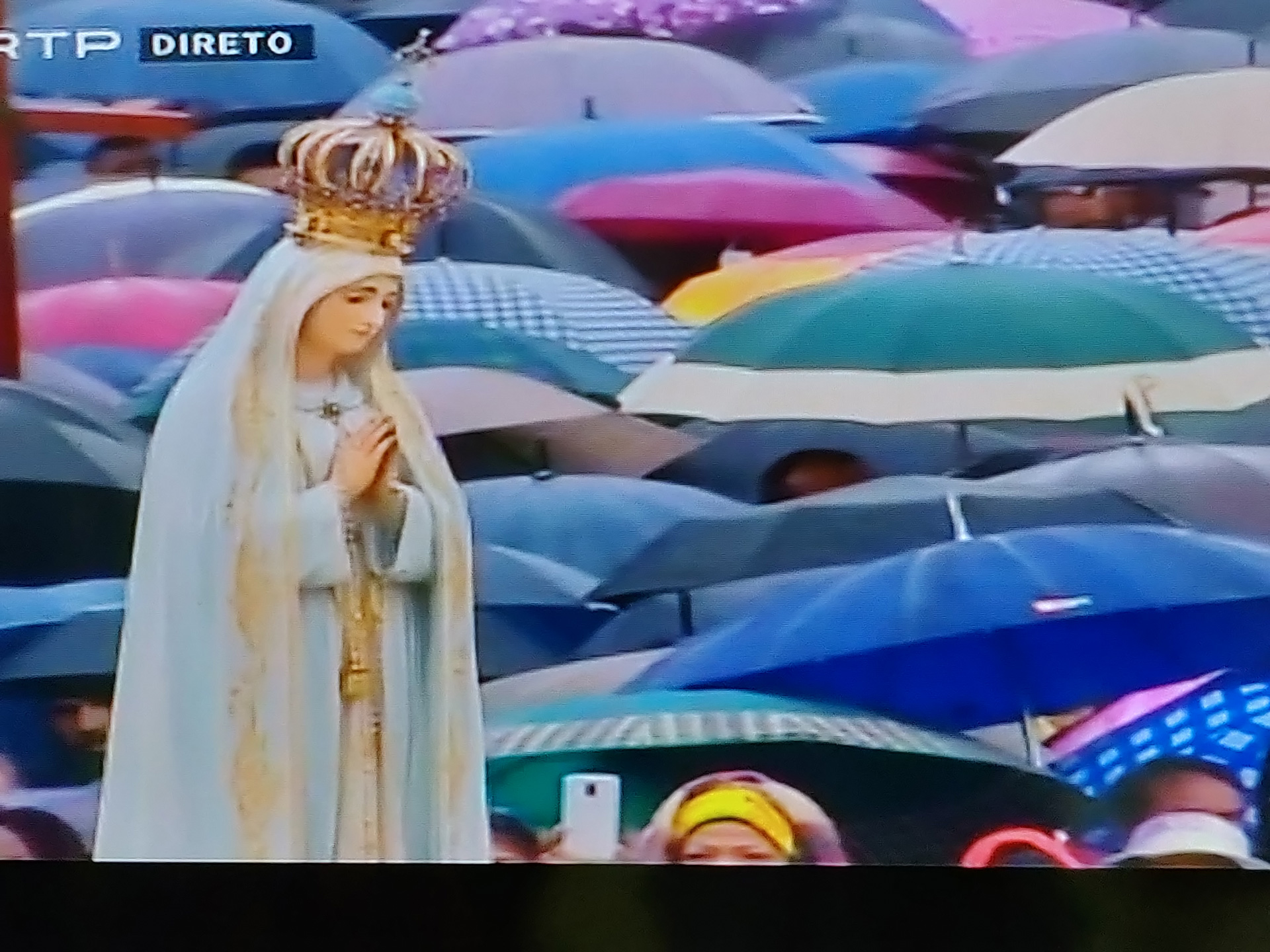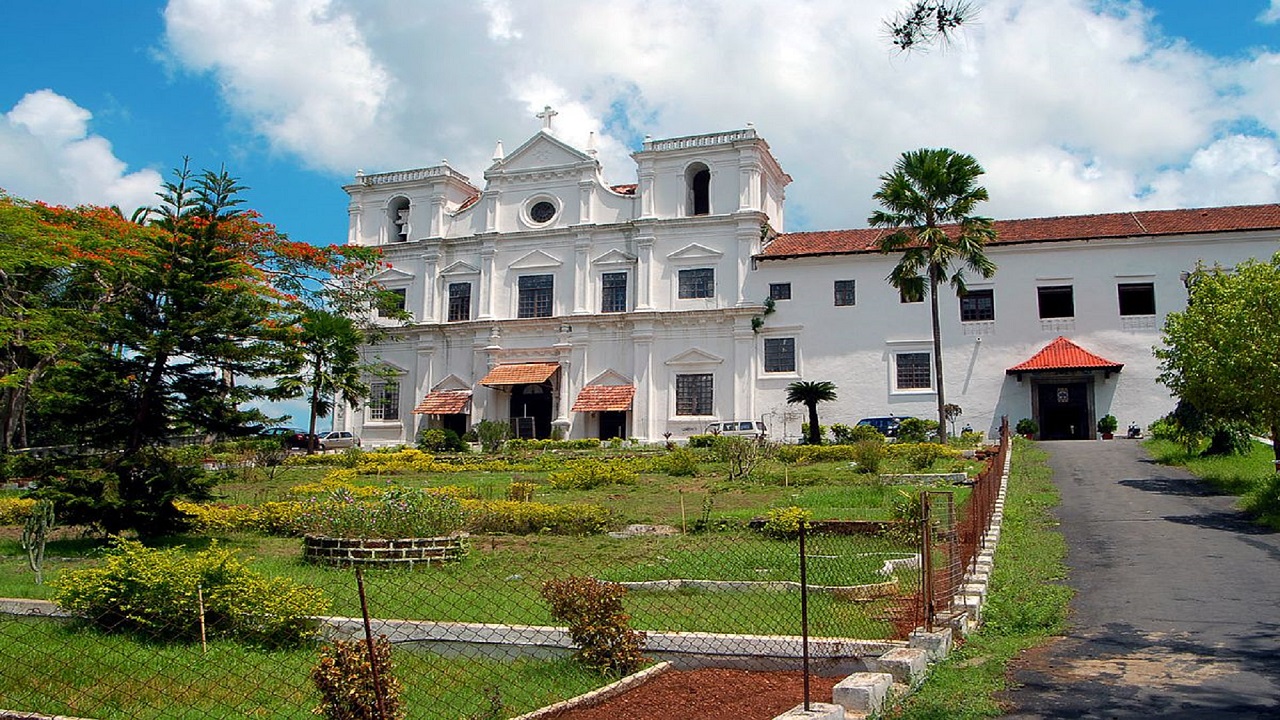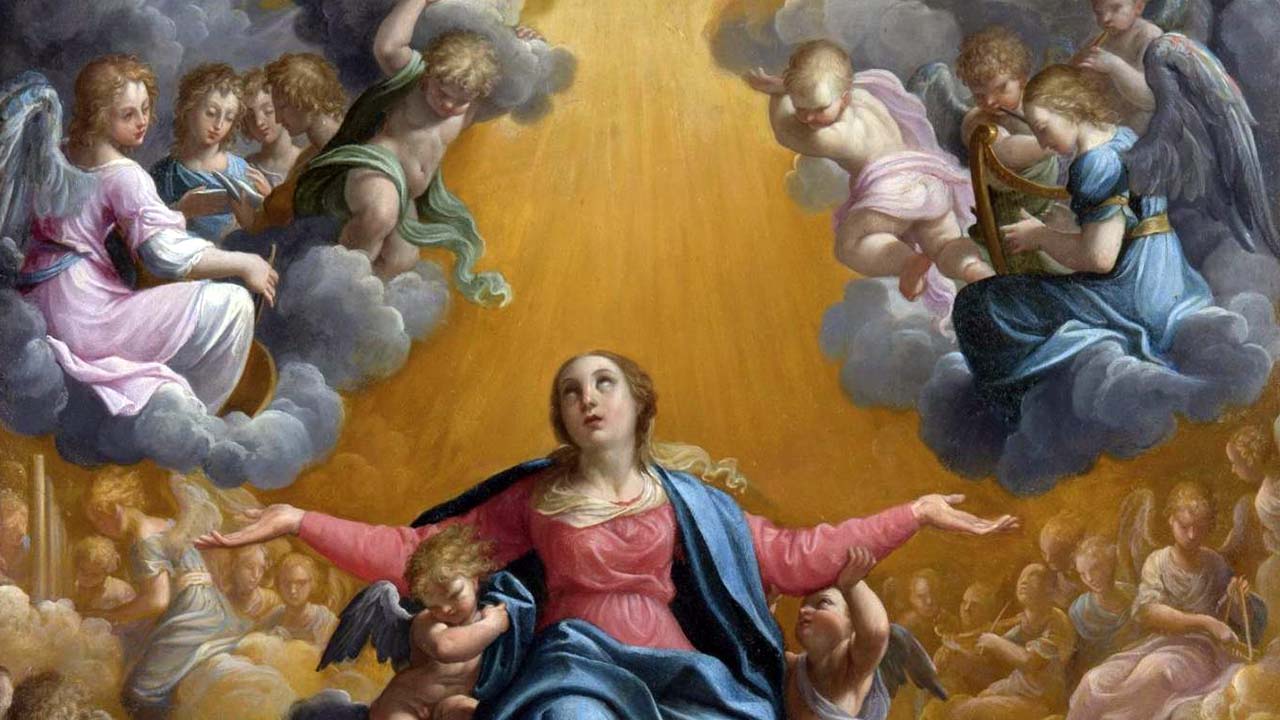Celebrating Peter and Paul
Have you ever wondered why the Church celebrates St. Peter and St. Paul on the same day, 29 June? The tradition can be traced back to at least the third century. It is commonly believed that the two apostles were martyred on the same day, albeit three years apart, in circa 64 AD and 67 AD, respectively, under the infamous Emperor Nero. Another theory is that the day marks the anniversary of the translation of their relics. These are two of the most important explanations for the joint celebration, possibly instituted in the year 258.
Before the Christian era, 29 June marked the pagan festival of Romulus and Remus, legendary twins who founded Rome. Romulus was the city’s first king, but its founding date was not 29 June, but 21 April 753 BC. And, whereas the blood brothers founded the City of Seven Hills, brothers-in-the-faith St. Peter and St. Paul founded Christian Rome and are the patron saints of the Eternal City. So, regardless of the backstory, it can well be said that the Church Christianised the date in question.

Origins
St Peter is the founder of the See of Rome, and like him, St Paul too preached the Christian faith in the city. It is there that both were executed and buried. Peter was crucified, upside-down at his request, because he claimed to be unworthy to die on the Cross like his Lord. He was buried on Vatican Hill, and centuries later, St. Peter’s Basilica rose over his tomb.
Paul, on the other hand, was prescribed death by decapitation, given that he was a Roman citizen; crucifixion was a punishment reserved for non-citizens and slaves. His remains are housed in the Basilica of St. Paul Outside the Walls.
However, the two apostles are not linked in death alone. There are several other similarities and dissimilarities in the lives of these two seminal figures of the early Church.
Peter, originally Simon, was a fisherman of Galilee. He was the first of the apostles to recognise that Jesus was ‘the Messiah, the Son of the living God’ (Mt 16: 16). Jesus named him Cephas (Petrus in Latin), which means ‘Rock’ in Aramaic, for he was to become the rock upon which Christ would build His Church. Although he had pledged his fidelity until death, he had a momentary loss of faith – for example, when walking on water with Christ – and on the night of Christ’s Passion, he thrice denied Him.
Paul, originally known as Saul, was born in Tarsus, a city in south-central Turkey, near the Mediterranean coast. He was a well-educated Jew and Pharisee. Whereas Peter had a personal relationship with Jesus, Paul never met Christ face to face, but scorned His teachings and persecuted Christians. When on a hounding mission to Damascus, his dramatic encounter with Christ changed it all for him.
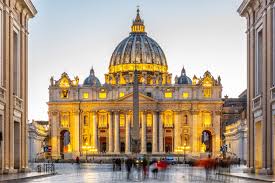
Turnaround
‘Every way of a man is right in his own eyes, but the Lord weighs the heart’ (Prov. 21:2).
Despite Peter’s many shortcomings, God chose him to shepherd His flock. The Acts of the Apostles notes that, in his capacity as the first bishop of Rome, he endured persecution and ensured that Christians kept the faith. St Peter is credited with writing two epistles: 1 Peter and 2 Peter. However, some scholars suggest that they may have been written by proxy.
Saul’s turnaround was even more spectacular. He continued on the road to Damascus with a contrite heart, received baptism, and got back his sight. Saul then became Paul. Breaking thus with his Hebrew identity, he exclusively used his Roman name, more familiar to Gentiles of the Mediterranean world, to reach a wider audience with the Christian message.[1]
St Paul spent the rest of his life in apostolic labours unequalled in Church history. While 13 letters included in the New Testament are traditionally attributed to him, many scholars believe that only seven are authentically Pauline: Romans, 1 and 2 Corinthians, Galatians, Philippians, 1 and 2 Thessalonians, and Philemon. The authorship of other letters, such as Ephesians, Colossians, 1 and 2 Timothy, and Titus, is debated.
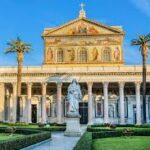
In our times
Peter and Paul are twin pillars of the Church. Their activity as the first Pope and as the Apostle to the Gentiles throughout the Roman Empire, respectively, quickly established Rome as the headquarters of the Church. The later recognition of papal primacy and the eventual establishment of the Vatican City within the city solidified its position as the Church’s central location.
The close association of Peter and Paul is clear. It is seen in theology and in art. There are also many churches dedicated to the pair. That is because, although distinct in origin and temperament, their ministries and teachings are complementary. This is all the more reason to celebrate them together. A partial indulgence is granted to the faithful who fervently recite the prayer in honour of the apostles on the Solemnity,[2] and a plenary indulgence to those who devoutly use a sacramental blessed by a bishop, provided they make a valid profession of faith during its use.[3]
Way back in the year 395, St Augustine of Hippo said of St Peter and St Paul: ‘Both apostles share the same feast day, for these two were one; and even though they suffered on different days, they were as one. Peter went first, and Paul followed. And so, we celebrate this day made holy for us by the apostles’ blood. Let us embrace what they believed, their life, their labours, their sufferings, their preaching, and their confession of faith.’
Notes
[1] In the first century, it was common for individuals to have dual names, one Hebrew and the other Roman, which they used interchangeably.
[2] “Partialis indulgentia conceditur christifideli qui orationem Sancti Apostoli Petre et Paule devote recitaverit. 'Sancti Apostoli Petre et Paule, intercedite pro nobis. Protege, Domine, populum tuum; et Apostolorum tuorum Petri et Pauli patrocinio confidentem, perpetua defensione conserva. Per Christum Dominum nostrum. Amen.” (in Enchiridion Indulgentarium, Concessiones, n°. 20, Libreria Editrice Vaticana, 4th edition, 2004, p. 67).
[3] "Christifidelis qui pietatis obiecto (crucifixo, cruce, corona, scapulari, numismate), a quovis sacerdote rite benedicto, pia utitur mente, consequitur indulgentiam partialem. Si autem pietatis obiectum a Summo Pontifice aut a quolibet Episcopo fuerit benedictum, christifidelis, eodem obiecto pia utens mente, assequi potest etiam indulgentiam plenariam die festo SS. Apostolorum Petri et Pauli, addita tamen, qualibet legitima formula, fidei professione." (in Enchiridion Indulgentarium, Normae, n°. 17, Libreria Editrice Vaticana, 4th edition, 1999).
References
https://www.catholicnewsagency.com/saint/sts-peter-and-paul-501
Catechism of the Catholic Church
Encyclopaedia Britannica
Freemantle, Anne (Ed.). The Papal Encyclicals in their Historical Context. New York: New American Library, 1956.
A Pope of Great Promise
The outcome of a papal conclave is always a surprise. Not only is the august assembly held cum clave, meaning under lock and key, the huge number of cardinal electors – who double as candidates – makes it impossible to guess who will emerge as the pontiff. Even though well before a conclave begins, different agencies float names of the papabile, these have only indicative value. The cardinal electors make their final decision on the spur of the moment, by the inspiration of the Holy Spirit. That’s how unpredictable a papal conclave can be.
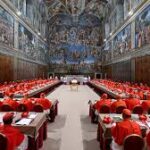
The secular world, however, looks at it as a numbers game or a power struggle. No doubt, historically, Europe has had the largest number of Popes (235/266), with Italians outnumbering them all (217). Yet it cannot be said that the papal office is racially defined. For instance, in the early centuries even the so-called Dark Continent produced Popes, whereas the white New World got its first one as late as the twenty-first century.
Furthermore, while 15 countries have produced Popes till date, including tiny Albania way back in the eighteenth century, longtime superpower USA had to wait until the twenty-first to have their very own top man at the Vatican. He possibly comes as a divine reward for the resurgence of faith and devotion (particularly with the National Eucharistic Revival) in his native country; but he has not trumpeted his national affiliations.
Finally, there will always be countries not making the grade, but surely no country or race will be deliberately excluded. So, no matter which part of the world the Pontiff comes from, he never fails to surprise.
First Impressions
The rise of Cardinal Robert Francis Prevost as an American is as good a surprise as it would have been if he were an Indian or an Australian. So long as he steers the Barque of Peter with faith and divine authority – that is all that matters.
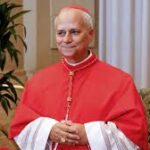
That is why, even before I got to see the man in the Loggia delle Benedizioni, I felt the blessing of the name he had assumed: Leo XIV. Much as we may say ‘What’s in a name?’, a name is not without historical and cultural significance. It is selected after much reflection and with a purpose. Presently, it symbolises strength, courage, power and the determination to begin a course correction. It represents the divine kingship and majesty of Christ. It stands for the teaching authority of Jesus, who is the ‘Lion of the Tribe of Judah’ (Rev 5:5).
After a quick minute of great anticipation, the French window finally opened. I saw the man in traditional vestments. What most impressed me was his calm and gentle demeanour, humility and unpretentiousness. He came across as a simple and sincere prelate. He seemed authentic and accessible, straightforward and down-to-earth, with the ability to call a spade a spade. While he looked at the cheering crowds with tenderness, he was far from being over the moon with delight.
An unmistakable change in that iconic balcony! I said to myself, let bygones be bygones; the past is behind us – the present and the future are all that matter. The Loggia of Blessings was to me a window on the future. I began to imagine Leo XIV restoring all things in Christ. Just then, I heard the Vicar of Christ's deeply evocative greeting – Peace be with all of you! – ‘the first greeting of the Risen Christ, the Good Shepherd who gave His life for God's flock.’
Like a tender father, the Pontiff wished ‘this greeting of peace to enter your hearts, to reach your families, and all people, wherever they are, all of the people, all over the earth.’ He followed it up with reassuring words: ‘God loves us, God loves you all, and evil will not prevail! We are all in the hands of God.’ Calling disciples of Christ to join hands and move forward, he focussed on the Divine Master alone, saying: ‘Christ precedes us. The world needs His light. Humanity needs Him as the bridge to allows it to be reached by God and by His love.’
And then, lo and behold, there came words and phrases that had almost fallen into disuse: his was a call to be ‘faithful to Jesus Christ, without fear, to proclaim the Gospel, to be missionaries.’ Pledging his service as a true son of Saint Augustine, he turned the people’s gaze to ‘that homeland that God has prepared for us.’ A man of deep faith and experience indeed.
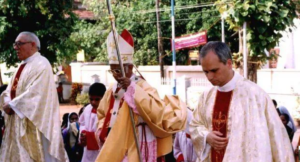

The Holy Father had a special greeting to the Church of Rome and to his diocese of Chiclayo, in Peru, ‘where a faithful people accompanied their bishop, shared their faith and gave so, so much to continue being a Church that is faithful to Jesus Christ.’ Words of gratitude, of encouragement, of zealous devotion are what we heard from the Loggia that blessed night.
But that is not all. His Holiness reminded the gathering that it was ‘the day of the Supplication to Our Lady of Pompeii. Our Mother Mary always wants to walk with us, to be close, to help us with her intercession and her love,’ and befittingly ended his first Urbi et Orbi blessing with a Hail Mary. I felt immensely comforted.
Tasks Ahead
The Lord our God has favoured us with Pope Leo XIV, thanks to the prayers of many zealous souls. For over a decade now, the likes of German Cardinal Gerard Müller, Guinean Cardinal Robert Sarah, US Cardinal Raymond Burke, German Bishop Athanasius Schneider; theologians, lay individuals and groups had been sounding the alarm bell about the waves of the world mercilessly buffeting the Barque of Peter. Providentially, the new Captain will steer the drifting ship back on course.
To my mind, the tasks ahead are many. Meanwhile, to maintain our integrity as Catholics, we must turn the spotlight on three fundamental issues. First, we must stress the importance and non-negotiable nature of the Sacred Tradition and the Holy Magisterium of the Church. As Cardinal Müller recently said, ‘the question is not between conservatives and liberals but between orthodoxy and heresy.’
Secondly, we must address the wrong notion that even some of us Catholics have of the Church’s mission. It is our duty to make Christ known, present, and active in the world. We must lead people toward a deeper relationship with Him and with one another. The Church is not a ‘humanitarian organisation doing social work’ but a spiritual lighthouse that affords a view of eternal life.
Thirdly, how can we recover from the identity crisis that ails us? It is fuelled by gas lighters, some of whom have infiltrated the Church. It is the proverbial smoke of Satan clouding our minds and making us look for validation from the secular world. The antidote is to appreciate, love and be grateful for the treasures of our Faith and our Church.

Let us entrust these issues and many others too long to list here to the leadership and wisdom of Pope Leo XIV and be continually surprised and amazed by God's work in our midst. No matter how hard it is to figure it out, he occupies the Chair of Peter by the express will of God, Who has said: ‘So is My word that goes out from My mouth: It will not return to Me empty, but will accomplish what I desire and achieve the purpose for which I sent it.’ (Is 55: 11).
Long live Pope Leo XIV!
Banner: https://www.thetablet.co.uk/news/first-urbi-et-orbi-blessing-of-the-holy-father-leo-xiv/
Prevost at the Vatican (2023) https://www.france24.com/en/europe/20250508-pope-leo-xiv-profile-robert-prevost-from-peru-missionary-to-first-american-pontiff
Mary to Mira: just a sound away?
The article titled ‘Milagris and Lairai: fostering the bond of divine unity’, by historian Dr Sushila Sawant Mendes (Herald, 23 April 2023)[1] has added to the myth rather than clarified it. One would expect to be enlightened on the origin of the statue of Our Lady of Miracles (also Milagr Saibinn, in Konkani), or the story of the Seven Sisters, or even be favoured with a sociological or anthropological explanation; but that was not to be. At any rate, as a lay reader, I wish to raise a few issues about its interface with Catholic practices in Goan society.
To start with, the loose use of the term ‘divine’ with reference to Our Lady leads to considerable confusion. Mary, the mother of Jesus, is not a goddess but a human being, whereas Lairai, shrouded in legend, is one of the seven sister goddesses to the Hindus. Why link a historical personage to a mythological septet? It is therefore gratuitous to put Lairai on a par with Milagr Saibinn.
Quite understandably, the article is riddled with expressions like ‘It is believed’ and ‘Legend has it’. But saying that “Milagris Saibin is believed to be the deity Mirabai, a sister of Goddess Lairai” begs the question: believed by whom? Is there a formal acceptance of the belief, or is it a belief held by an amorphous mass of individuals that offer flowers or pour oil on the statue? The latter practice is, perhaps, of recent origin and the only one of its kind in Goa.
From the Catholic perspective, the story is not Mariological. And stating that “There is a tradition to offer oil to the Milagris Saibin from the Shirigao Devasthan and mogra flowers are offered to Lairai Devi from the St Jerome Church in Mapusa” is not in keeping with any official Catholic tradition in Goa. So, the onus of showing the origin of such a protocol, if any, lies on our historian-writer.
That the purported institutional exchange is a no-no even from the Hindu side was confirmed by iconographer Dr Rohit R. Phalgaonkar, who has researched the issue.[2] No doubt, Mirabai was one of the seven sisters from folklore, but after her abode, Mapusa (not Mayem, as stated in the article), converted to the Catholic faith, way back in the sixteenth century, the temple authorities in Shirigao (and elsewhere) stopped mentioning Mirabai in the traditional invocations. In fact, “none of the sister temples make a reference to Milagris in their official records and in the religious duties or rituals that they perform at the festival. She is not an icon of the Hindus; she is a Christian icon," he added.[3]
Therefore, to say that Milagr Saibinn has taken the place of Mirabai is not plausible; and Dr Phalgaonkar wonders why Milagr Saibinn would have a link with Lairai alone and not with the other sisters! This only goes to prove that, if the issue is not handled with academic rigour, it can be grist to the myth-making mill even in our day and age.
Not surprisingly, there is a dash of magic realism, which helps bring the story alive: “… it is believed that the two sisters visited each other on the day of their respective festivals.” And risking repetition, the writer says, “Folklore tells us that Milagris Saibin would send flowers as a gift to her sister, Goddess Lairai, during the zatra. Lairai would send in turn oil for her sister’s feast.” That is to say, while earlier on in the article, the two institutions were given credit for the magical feat, now it is Milagr Saibinn and Lairai Devi themselves who show how they care for each other! Can scientific writing sacrifice accuracy at the altar of artistic licence?
With the theme of unity and a sense of disclosure ever present, the writer is keen to show that Goa is an oasis of intercommunal peace; and she bends over backwards to prove her point. That “every generation of the people of Assolna, Velim and Cuncolim have grown up with the belief that the Goddess Shantadurga of Fatorpa is the sister of Saude Saibin of the Church of Our Lady of Health in Cuncolim” is either an exaggeration or it speaks poorly of the catechesis received by the Catholics of those villages (AVC).
That is a facile generalisation, which, read alongside the sentences now in parentheses (“The festival of the Sontrios in Cuncolim and the devotional visits of the Catholics to this temple is a graphic representation of this undying belief. Tomorrow is both the feast of Milagres Saibin at Mapusa and the Shree Devi Lairai Zatra at Shirigao, both to be celebrated on the same day after thirteen years, on April 24 this year”) summarily puts Catholics across the length and breadth of Goa under the sontri or umbrella of a syncretic religion.
The article runs high on emotions. After referring to Lairai’s many sisters, the writer states: “Since all are still sisters, it is understood that people worship at either their temples or churches. It is an emotional explanation of how Goans are still one people with one culture even if, on the surface, they are divided.” Is the writer implying that Goans randomly visit places of worship – and does that effectively prove that they are “still one people with one culture”?
It is undeniable that the Indian Constitution allows freedom of religion and worship, but does that lead to licence? We get the impression that Goan Catholics and Hindus have no sense of belongingness and loyalty: they run with the hare and hunt with the hounds. Especially Catholics, followers of a monotheistic religion, to insinuate that they worship indiscriminately is a slur on their character.
We are catapulted into the next stage of mythification, on reading the story of Lairai fighting with her brother Khetko. When the writer says that “The ceremonies [at Shirigao] culminate when devotees walk through fire as acts of repentance by the two sisters who had mistreated their brother”, it is not clear which sister fought alongside Lairai and has been paying for it till date. Contextually, or say, in the writer’s variant of the myth, would it be a reference to Mary who has supposedly replaced Mirabai? The fact of the matter is that Mary had no brother and her world was one of meekness and peace.
Is it only a step from Mary to Mira? Or so it is made to appear – just a transposition of syllables! Whether or not “Goans worshipped the Mother Goddess in a number of forms even before the Portuguese arrived”, it is improper to say that “with the coming of the Portuguese, the Virgin Mary was introduced in her various versions”, for the Blessed Virgin Mary has no “versions” but only invocations and titles. Add to it the statement that the “Goans thus turned from one form of Mother Goddess to worship another”, and you have a gross oversimplification of the historical situation! And needless to say, to examine the claim that “many temples dedicated to the Mother Goddess were rebuilt as churches dedicated to Our Lady” would require a thorough historical approach.
To conclude: Considering that no society is devoid of myths, or even completely homogeneous in its myths, we can make allowances for the article’s ‘mythical reasoning’. India is a land abounding in myths and legends; we usually take them in our stride, considering that they have come down from a remote past over which we have no control.
Accordingly, living as we do in a secular democracy striving towards peaceful coexistence, the writer has ended up secularising the myth, of course, cherishing a well-founded hope for “a strong bond of unity”. But whereas this unity is desirable and even achievable at the social level, to endeavour to merge institutional identities, unite heterogeneous beliefs, and mix up religious doctrines is unacceptable.
Can we guard against processes leading to new myths? It is the bounden duty of academics to get to the bottom of it lest peace and unity become a myth.
Banner: https://gogoanow.com/milagres-feast-celebrated-st-jeromes-church/
[2] Cf. his lecture titled ‘Seven Sister Goddesses’ at https://www.youtube.com/watch?v=BDsQFx4jpII
[3] Interview with Dr Rohit R. Phalgaonkar, 28/29.4.2023.
Fatima, alive and tender
Today is the 104th anniversary of the Apparitions of Our Lady of Fátima. It is also the 75th anniversary of the crowning of the Statue and the 40th anniversary of the attempt on the life of Pope John Paul II at St Peter’s Square.
In the words of the Rector, while the silver and gold of that crown represent the joys of life, the bullet fitted therein represents our life’s sorrows.
The four-hour ceremony on this rainy morning at Fátima began with a multilingual recitation of the Holy Rosary and ended with Holy Mass presided over by Cardinal José Tolentino de Mendonça.
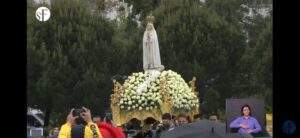
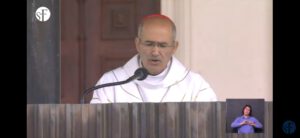
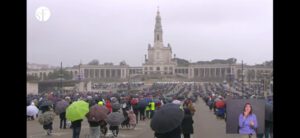

It was a touching testimony of love from pilgrims (number restricted to 7500, in keeping with covid-related SOPs) to their Mother, Queen of Heaven and Earth, who is always alive and tender.
St Joseph: unsuspecting, silent, forgotten
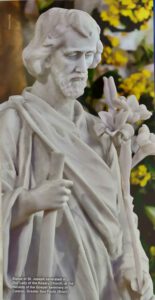
Those three adjectives popped into my head as I spent 1 May pondering the life of the foster father of Jesus. And come to think of it, what do we really know about him? Except for some passages in Matthew and Luke, even the Scriptures have scanty information on his life journey.
Trust and wisdom
Joseph, who was a descendant of the house of King David, exhibited no trappings of royalty. He was only betrothed to Mary, a virgin, when, mysteriously, he found her pregnant. He graciously refrained from condemning her; as “a righteous man and unwilling to expose her to public disgrace” (Mt 1:19), he'd thought of discreetly divorcing her. But this would surely have left the maiden defenceless against a bigoted Jewish society – or so it dawned on him after an angel revealed him God’s magnificent designs. Trusting the divine messenger, he promptly took Mary as his wife. Thus, the role of Joseph who was blessed with expectant faith and total trust would soon prove to be crucial in the history of salvation.
What was Joseph like, as a husband and father, professional and citizen? One thing is for sure – he wasn’t a loudmouth; quietness was his watchword. Soon after Jesus’ birth, he quietly fled with the family to Egypt, escaping carnage of infants at the hands of king Herod of Judea. They returned only after the ruler’s death and settled in Nazareth, far from the glare of the capital city, Jerusalem. He worked as a modest carpenter, and was helped by his divine son. A dutiful citizen that he was, he’d earlier made a trip to his city, Bethlehem, to enrol the couple in the census. Finally, Joseph was a devoted father too; he joined Mary in searching for their son lost in Jerusalem. But then, quite perplexingly, even here we don’t get to hear his voice.
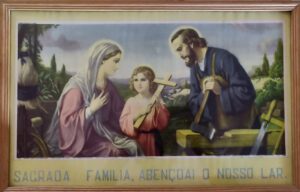
Pope Benedict XVI has stated that Joseph led a “simple and industrious life, cultivating the conjugal relationship with care and fulfilled with enthusiasm the great and difficult educational mission.” (Angelus, St Peter's Square, 19 March 2006) Yet, in modern parlance, we tend to dismiss such a man as lacking l’esprit. So, could it be that Joseph’s portrayal as an old and unattractive man induced the silence that we’ve weaved around him down the centuries? Some believe that his elderly mien is meant to account for his wisdom fit for the father of Jesus. And hopefully, showing him as past his prime would help explain how he abstained from conjugal relations with a young and pretty wife.
While the Pope Emeritus makes ample references to how Joseph treated Mary with love and care, Fulton Sheen, portrays the Saint more dramatically, in The World’s First Love. He profiles him as “probably a young man, strong, virile, athletic, handsome, chaste, and disciplined, the kind of man one sees… working at a carpenter’s bench.” Although society then was probably less conscious of physical attributes than we are today, those are some that would rightly distinguish the holy family of Nazareth. And practically speaking, how else would a man provide for a family of three?
The insightful Archbishop has a take on Joseph’s libido as well: “Instead of being a man incapable of loving, he must have been on fire with love.” But, then, as a counterpoint he sheds light on how “young girls in those days, like Mary, took vows to love God uniquely, and so did young men, of whom Joseph was one so preeminent as to be called the ‘just’. Instead, then, of being dried fruit to be served on the table of the King, he was rather a blossom filled with promise and power. He was not in the evening of life, but in its morning, bubbling over with energy, strength, and controlled passion.”
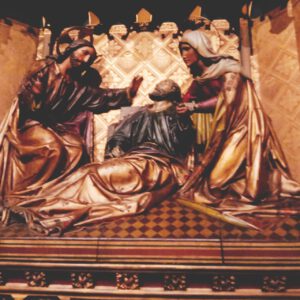
That’s how Joseph must have lived the elevated life that God had called him for. The circumstances of his death are unknown, but it is surmised that he died before Jesus’ public life began, if not, certainly before the Crucifixion (Jn 19: 26-27). We could reason out that God thus saved him the anxiety of seeing Jesus vilified in his public ministry: really, how would a father – an honourable man – take it lying down? It might have well compelled him to come out into the open and defend his son. But if this conjecture be false, God for sure saved him from the cruelty of witnessing the humiliating death of his Son on the Cross.
Honouring Joseph
Be that as it may, Joseph was an unsuspecting man, for he trusted in the Lord; he was silent, as he knew how to take it all in his stride. So now the moot question is: why do we forget him so very easily?
Curiously, veneration of Joseph began in his land of self-exile, Egypt, and the same took about thirteen centuries to take root in the West. This finally happened when the Servites, an order of mendicant friars, began to observe his feast on 19 March, the traditional day of his death.
Later promoters of the devotion included Pope Sixtus IV, who introduced the feast circa 1479, and the celebrated sixteenth-century mystic St Teresa of Avila, who attributed her miraculous cure of paralysis to him. After Mexico, Canada, and Belgium declared Joseph their patron, Pope Pius IX in 1870 declared him patron of the Universal Church. In 1955, Pope Pius XII established the Feast of St Joseph the Worker on 1 May as a counter-celebration to the communist-sponsored May Day.
A feast day, however, should rise above tokenism. We must therefore have recourse to this admirable saint – emblematic of the world's forgotten fathers – in the ups-and-downs of our daily life. No artist or writer has captured the essence of the man as beautifully as the litany in his honour has: “St. Joseph – chaste guardian of the Virgin, foster father of the Son of God, diligent protector of Christ, head of the Holy Family, most just, most chaste, most prudent, most strong, most obedient, most faithful.”

Closer to our times, Pope Benedict XVI highlighted a much neglected aspect of Joseph’s life – chastity – by introducing the reference in the Eucharistic prayer, after Mary: “St Joseph, her Most Chaste Spouse”. (Why many celebrants avoid the operative word is anybody’s guess) The Pope revealed that his predecessor, John Paul II, who was devoted to St Joseph, and dedicated to him the Apostolic Exhortation Redemptoris Custos (Guardian of the Redeemer), experienced his assistance at the hour of death.
In an era when fatherhood is relegated to the background even in birth certificates; masculinity is equated with machismo; and chastity disdained in the age of the sexual revolution, we are invited to emulate the counterexample of St Joseph.
In particular, on 1 May, let us make Pope Pius X’s Prayer to the Model of Workers our own, so that our labour and toil may draw abundant fruit in this valley of tears, particularly given the rapid and complex changes due to happen in the covid and post-covid eras.
(To the memory of my parents Fernando de Noronha and Judite da Veiga, on their 56th wedding anniversary)
Credits:
Pic 1 - Statue at Our Lady of the Rosary Church, Heralds of the Gospel Seminary, Caeiras, Greater São Paulo, Brazil. Taken from the magazine of the Heralds of the Gospel (Vol. V, No. 43, May 2011)
Pic 2 - Frame that my parents made it a point to gift to each of their five sons at their marriage.
Pic 3 - Death of St Joseph: panel of the Church of Our Lady (Onze Lieve Vrouwekerk, Amsterdam). Information provided by my friend Caetano Filipe Colaço (Margão/Dona Paula)
Pic 4 - Prayer to St Joseph, Model of Workers, composed by St Pius X. Source: magazine of the Heralds of the Gospel (as above)
(Also published in The Examiner, December 2021)
Lent: how and why
Why is the 40-day period leading to the commemoration of Jesus’s Passion, Death and Resurrection called ‘Lent’? ‘Lent’ was originally a secular word (from lencten, the Old English word for ‘lengthen’) referring to the lengthening of days in the season of spring. Over the centuries ‘Lent’ became synonymous with the liturgical period as this always fell during the springtime in Europe. Besides, it was an easier word than the official Latin Quadragesima, literally, 40th day before Easter.
That today the period from Ash Wednesday to Holy Thursday (afternoon) actually comprises 44 days is another thing. This mismatch is a result of the post-Vatican II reorganization of the liturgical year and calendar: considering that the rite of ashes had become very popular, even more than many other days of greater solemnity, it was decided to have Lent prefixed by the days from Ash Wednesday to Saturday. Minus those days, the number is 40.
Historically, Quadragesima is the bare minimum period of Lent. In earlier times there was a remote preparation comprising three weeks: the Septuagesima, the Sexagesima, and the Quinquagesima that acted as a bridge between joyful Christmas and sobering Lent. The ashes have now become a reminder that the first Sunday of Lent – the Quadragesima – is round the corner, to begin the commemoration of the 40 days Jesus spent fasting in the wilderness.
That is how fasting has become inseparable from the penitential period. Earlier, fasting was throughout Lent except Sundays, in keeping with the primacy of this day as a joyful feast honouring the Resurrection of Christ. With the reorganization of Lent in 1969 it ceased to be a season of fasting. Presently, only two days – Ash Wednesday and Good Friday – are prescribed as days of fasting. For their part, Lenten Sundays play the role of shaping the week’s liturgical focus and provide the base of all the liturgy building up to Holy Week.
How long or short a period of Lent we have is finally a matter of individual choice; we know best why we abstain or refrain from certain foods; and how beneficial the season is going to be is finally left to me and my God to work out. However, if we are attuned to the liturgical seasons, we will already feel a pull towards Lent much before it actually begins; if fasting is not a matter of mere protocol we will happily go the extra mile. With the freedom we have received, we are, so to say, masters of our destiny.
Knowing the meaning and necessity of the Lenten season can help us guide our own destiny. St John Paul II summarized it well when he said: “Here then is revealed which, by its call to conversion, leads us through prayer, penance and acts of fraternal solidarity to renew or reinvigorate our friendship with Jesus in faith, to free ourselves from the deceptive promises of earthly happiness and once again to savour the harmony of the interior life in authentic love for Christ.”
That’s how and why Lent is considered a spiritual spring: we are renewed in fervour and become a vessel unto honour.
The Last Things – First!
“In all thy works remember thy last end, and thou shalt never sin.”
(Ecclesiasticus, 7:40)
When we lose a loved one, our hearts ache and a great unease pains our sense. Wrestle how we might, we come to accept the reality only after we have decided, like Keats in ‘Ode to a Nightingale’, that to them ‘now more than ever seem[ed] it rich to die, to cease upon the midnight with no pain’. Eventually, we gratefully recognize that history had been unfolding before our very eyes through God’s infinite wisdom, mercy and goodness. Peace descends on us and the former unease turns into a wish simply to remain spiritually united with the departed soul.
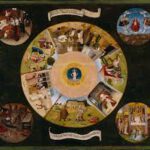
Taking in the inexorable mystery of death – and, specifically, the passing away of a near and dear one – is an important milestone in our lives. Helen Keller once said apropos the proper use of the physical senses: “Sometimes I have thought it would be an excellent rule to live each day as if we should die tomorrow. Such an attitude would emphasize sharply the values of life. We should live each day with a gentleness, a vigour, and a keenness of appreciation which are often lost when time stretches before us in the constant panorama of more days and months and years to come. There are those, of course, who would adopt the Epicurean motto of ‘Eat, drink, and be merry’, but most people would be chastened by the certainty of impending death.”
Many of us would also wish to gaze beyond our earthly life, seeking to understand what is to become of us after death. And should we wonder why we are born at all if we are to die some day, we will realize that there is more to life than just this earth. It requires only that leap of faith to see that, like matter, the soul changes its form but is never destroyed; that life returns to where it has come from: the bosom of the Lord!
Communion of Saints
Catholic doctrine has comforting answers to the eternal questions of Life and Death: it would be of immense spiritual profit if we learnt them in time, so that whether or not we gain this whole, wide world, we might be poised to earn the next!
The Catechism of the Catholic Church (CCC) teaches us that, living or dead, when in a state of grace we live in Christ as ‘saints’; that there is the church of heaven and of earth, where the saints live in communion with each other and with God, much in the manner of the Triune God!
The CCC emphatically says, “What is the Church if not the assembly of all the saints? The communion of saints is the Church,”[1] and goes on to explain that the term has two closely-linked meanings: communion in holy things and in holy persons.[2]
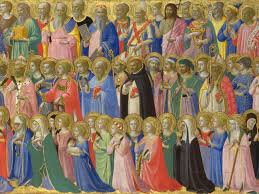
The communion in holy things or spiritual goods comprises (1) the faith received from the apostles and kept alive through prayer; (2) the sacraments, most importantly the Eucharist; (3) the charisms, or graces that the Holy Spirit distributes among the faithful for building up of the Church; (4) our possessions, which are, really speaking, the Lord’s goods under our stewardship; and, finally, (5) love, whereby if one member suffers, all suffer together; if one member is honoured, all rejoice together.
The communion in holy persons refers to the life that the saints of heaven and earth live in common. While some of Christ’s disciples are still pilgrims on earth, others have died and are being purified; yet others are already in glory, contemplating God in full light. The exchange of spiritual goods, while it helps the departed to attain the Beatific Vision, also makes their intercession for us effective. Finally, being more closely united to Christ, they fix the whole Church more firmly in holiness.
In his book True Spiritualism, Fr. C. M. de Heredia, S.J., calls the Communion of Saints “a Divine Corporation, a great communism in which all the saints in heaven and all the souls in purgatory and all the children of the Church on earth form one vast family, of which Christ is the head, and participate in all spiritual goods that are in common.” The early Christians in Jerusalem “had but one heart and soul; neither did any one of them say that, of the things which he possessed, anything was his own; but all things were common to them. [...] And those who had houses and lands sold them and laid the price at the feet of the Apostles who distributed them to every one according to their needs.” (Acts 4: 32, 34) The Communion of Saints is this same idea “raised to the heavenly sphere, embracing both planes of existence, enveloping the finite world and entering into the infinite, the idea that makes common property not so much of earthly as spiritual goods.”[3]
Vocation of the Church
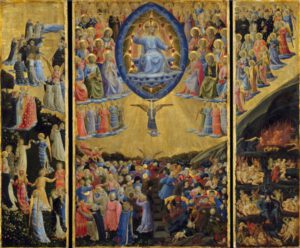
The CCC says, “If we continue to love one another and to join in praising the Most Holy Trinity – all of us who are sons of God and form one family in Christ – we will be faithful to the deepest vocation of the Church.”[4]
What is the deepest vocation of the members of the Church? It is to know God, love Him and serve Him. So it behoves us to learn how to do all these things! We should (re-)arrange our worldly priorities so that God becomes the centre of our lives and is forever praised in all that we do. On balance, this is what holds out the eternal reward after our life in this valley of tears!
“It has been alleged oftentimes,” says De Heredia, “that the Church has taught that in this world there is nothing but misery, and that she is not for this life but for the next. Well do we know how erroneous that is! As the soul is greater than the body even in this life, so does it follow that the pleasures of that soul are greater than the pleasures of the body. It is the Church which teaches us how to be happiest in this life and happiest in the next. The philosophy that reduces the world’s playthings to their proper perspective and makes man at once great in the accomplishments of earth and at the same time divinely indifferent to them is hers. [….] No hedonist, no aesthete, however rapturous his pagan worship of beauty, can equal the Catholic even in pursuit of earthly happiness.
“But immeasurably beyond these sources of joy, the Catholic has his firm hope in the everlasting happiness of heaven. He has his trust in a God who loved man so much that He came to earth and died for him. The light of Paradise is in his eyes. The beauty of God illuminates his soul. The caresses of his Heavenly Father are on him. And he has his belief in the power and companionship of the Communion of Saints.”[5]
Last Things First!
The communion of saints is a marvellous reality.[6] But this can be fully appreciated only against the background of eschatology, the teaching about the ‘Four Last Things’: death, judgement, heaven and hell. These apply to the individual, while the resurrection of the bodies and the final judgement at the second coming of Christ are for the human race as a whole.
Knowledge about the ‘Last Things’ is best not left for the last moment (as St Francis of Assisi says, “We shall die sooner than we expect”). We are duty-bound to see that the ‘communion of saints’, ‘the forgiveness of sins’, ‘the resurrection of the body’, and ‘the life everlasting’ from the ‘I Believe’ are not mere words but operating realities! We must understand that the ‘hour of death’ that the ‘Hail Mary’ reminds us of is not just another moment in a distant, even undefined, future but could come sooner than later! And we who recite the ‘Our Father’ and assist at Mass would do well to learn what is meant by the ‘Kingdom’ and ‘Eternal Life’! Such fundamentals of our faith have to be transferred from the tomes of theology to the homes of everybody – meditated upon, discussed, internalized, and acknowledged in our daily life. Or even a prayer, like the following one to St Joseph, composed by none other than Pope Pius X, points to the true worth of those concepts.
O Glorious St. Joseph, a model for all who are devoted to labour, obtain for me the grace to work in a spirit of penance, for expiation of my ma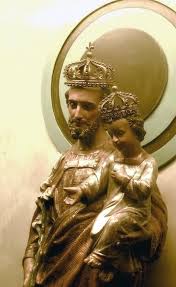 ny sins; to work conscientiously, putting the call of duty above my inclinations; to work in recollection and joy, deeming it an honour to employ and develop through labour the gifts received from God; to work with order, peace, moderation, and patience, never shrinking out of weariness and trials; to work, above all, with purity of intention and with self-detachment, having ever before my eyes death and the account that I will have to render of time lost, talents wasted, good omitted, and vain complacency in success, so baneful to God’s work.
ny sins; to work conscientiously, putting the call of duty above my inclinations; to work in recollection and joy, deeming it an honour to employ and develop through labour the gifts received from God; to work with order, peace, moderation, and patience, never shrinking out of weariness and trials; to work, above all, with purity of intention and with self-detachment, having ever before my eyes death and the account that I will have to render of time lost, talents wasted, good omitted, and vain complacency in success, so baneful to God’s work.
All for Jesus, all through Mary; all after thy example, O Patriarch St Joseph! This will be my watchword in life and in death. Amen.
This is eschatology made simple... eschatology in action! We are gently reminded that this world and the next are seamlessly woven into one whole; that what we do now – and how we live and work – determines our later fate.
It is easy to see that the Last Things are relevant not only to the afterlife but also immensely so to our present life. By letting us realize our final end, they bring about the required change in our worldview. They determine our dreams and aspirations as well as our response to earthly trials and temptations; they shape the nature of our hope and our way of life. They teach us why it is natural to seek first the kingdom of God and its justice; and how to be in the world and not of it.
It is surprising that we Catholics seldom talk actively about the Last Things. It is as though a conspiracy of silence is militating against our understanding them fully, thus even giving Eternal Life a semblance of fiction. Alas, we fail to realize that, by ignoring this real important aspect of our Christian existence, we let pessimism and despair cloud our consciousness. This is truly asphyxiating for the Catholic soul.
On the other hand, the greater our engagement with the Last Things the better it is for God’s people. A culture of hope and consolation is fostered, lending that much-needed supernatural quality to our being. We begin to live an integrated Catholic life. The communion of saints in heaven and earth is made active, and the Kingdom comes.... All good enough reasons to put the Last Things first!
(Renovação/Renewal, Goa, 16-31 August 2011)
[1] CCC 946
[2] The communion of saints is not linked to ‘spiritism’ (contact with the dead), which is disallowed by the Church.
[3] C. M. de Heredia, True Spiritualism, P. J. Kenedy & Sons, New York, 1924, p. 9-10
[4] CCC 959
[5] Op. cit., p. 28-29
[6] Whoever doubts this may refer to a simple little book, Read me or Rue it, by Fr. Paul O’Sullivan, O.P., TAN Books, 1992 (First published in 1936, with approval from His Eminence the Cardinal Patriarch of Lisbon): It carries captivating true stories about the Poor Souls in Purgatory.
Aquela doce palavra ‘Fátima’…
Era eu ainda menino quando ouvi da boca da Avó Leonor a história de Nossa Senhora de Fátima. Nessa altura, foi o enredo, ou seja, a descrição pastoral, que deveras me impressionou; e também o facto de a Mãe de Jesus ter pedido a recitação diária do Terço e que os maus se tornassem bons para poderem alcançar o Céu.
De vez em quan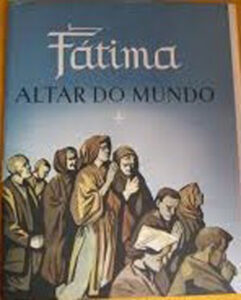 do ia lendo umas publicações sobre Fátima que tínhamos na nossa biblioteca em casa – uma delas, Fátima, Altar do Mundo, de João Ameal. Atraía-me esse fantástico subtítulo – “Altar do Mundo” – bem como as lindas fotografias a preto e branco.
do ia lendo umas publicações sobre Fátima que tínhamos na nossa biblioteca em casa – uma delas, Fátima, Altar do Mundo, de João Ameal. Atraía-me esse fantástico subtítulo – “Altar do Mundo” – bem como as lindas fotografias a preto e branco.
Uma outra publicação que costumava folhear era o Souvenir publicado em Goa por ocasião do cinquentenário das Aparições de Fátima (1967). Tinha artigos da autoria de escritores goeses – inclusive hindus – escritos em português, inglês e concani.
Nesse opúsculo vi pela primeira vez uma foto memorável de que falava meu pai: a Imagem da Virgem Peregrina a atravessar o rio Mandovi, a caminho da Velha Cidade, no dorso dum gasolina que se apresentava em forma dum grande cisne branco fabricado por artistas goeses. E, desembarcando junto ao Arco dos Vice-reis, essa imagem seguiu em magno cortejo até o local onde iriam ser rezadas, simultaneamente, 153 missas, a representar as Ave-Marias do Rosário! Que imponente cena! Nessa visita que se realizou de 29 de Novembro a 12 de Dezembro de 1949 a Imagem percorreu o território de Goa.
Daí a vinte e cinco anos, ou seja, em 1974, foi anunciada uma outra visita da Imagem. Desta vez, houve grande polémica na imprensa local. Não me lembro qual foi o argumento principal; sei só que se tratava de um debate entre duas gerações de clérigos goeses. Porém, quando chegou a Imagem houve grande concorrência dos fiéis. Com os meus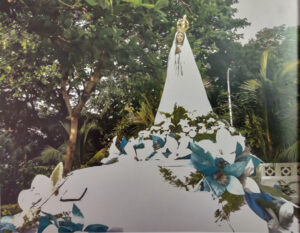 9 anos de idade fiquei com esta dúvida: como é que podia haver duas opiniões sobre a visita da Mãe de Jesus?!
9 anos de idade fiquei com esta dúvida: como é que podia haver duas opiniões sobre a visita da Mãe de Jesus?!
Entretanto, constituíam já uma tradição consagrada as chamadas procissões de velas, que se realizavam na capital, em Maio e Outubro. Era entoado um e outro cântico em português. Embora parecesse um simples ritual herdado a Portugal, para mim era esse país era o “povo escolhido” dos tempos modernos (já que o antigo não se portara bem!)
Também meu pai, de saudosa memória, sem nunca se esquecer do sentido mais amplo da mensagem de Fátima, parecia frisar o lado português do grande acontecimento que se tinha dado em Fátima, exprimia esse sentir no seu poema “Portugal e Fátima”, que veio publicado n’O Alcoa, de Alcobaça:
Portugal e Fátima Primeira Grande Guerra… Só sangueira, Luto e desolação por toda a Terra!… Angustiada, aparece, pois, na Serra A nossa Virgem Mãe numa azinheira (Cova da Iria); e diz com emoção que vão cessar as hostilidades (é a bonança a seguir a tempestades). Anima o mundo à sua reconstrução. E a Portugal diz:- Eis que te darei Dois jovens que guiarão nessa peleja: Um, que traz veste da cor de cereja; E o outro, de quem muito justamente d’rei: Tem muito sal na fala e afasta o azar.– E assim foi, pois: seguira-se uma era De real prosperidade e paz sincera, Por cerca de meio séc’lo, sem armar… Tal como não há rosas sem espinhos, Não podem faltar cravos nem cravinhos Que perturbem a vida nacional Neste sempre querido Portugal! Mas, haja o que houver, disse a Senhora de Fátima que é sua protectora nata:- “Meu Coração, pois, triunfará”. E, quem acreditar não poderá?
Em 1987, tive o ensejo de visitar Portugal. Fui a Fátima, onde vi peregrinos de joelhos; e uns a cantar e outros a chorar… Emocionante! Impressionou-me bem o recinto do Santuário e a vasta praça pública mas fiquei triste por ver uma intensa actividade comercial ao redor!
Entretanto, fui reflectindo sobre o facto de Fátima não ser um mero sítio ou história: os três pastorinhos eram afinal personagens ímpares no palco internacional e arautos da mensagem divina que merecia bem ser escutada pelo Planeta Terra.
Depois que voltei a Goa, em 1988, estive em contacto com a Sociedade Brasileira de Defesa da Tradição, Família e Propriedade, que tinha acabado de publicar o livro intitulado As Aparições e a Mensagem de Fátima nos manuscritos da Irmã Lúcia, de autoria de António Augusto Borelli Machado. Este livro teve depois uma edição inglesa, feita em 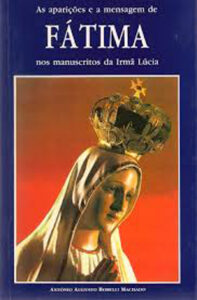 Goa. Eram os anos do desmoronamento do Império Soviético e outros acontecimentos apocalípticos cuja explicação completa se encontrava na mensagem de Fátima.
Goa. Eram os anos do desmoronamento do Império Soviético e outros acontecimentos apocalípticos cuja explicação completa se encontrava na mensagem de Fátima.
Tornei-me ainda mais devoto da Senhora de Fátima. Mas enquanto eu fitava a sua dimensão universal, Nossa Senhora olhava, com carinho maternal, para a minha vida pessoal: ajustar-me-ia com a Isabel, nascida em 13 de Maio, e levando por isso os nomes Maria e Fátima!
Cinco anos depois, casámos nesse dia. No fim da missa do casamento a Isabel fez (e eu renovei) a Consagração a Nossa Senhora segundo o método de S. Luís Maria Grignion de Montfort!
Uma e outra pessoa, católica mas também supersticiosa, nos tinha recomendado não casar no dia 13, sexta-feira. Mas pusemo-nos, a Isabel e eu, incondicionalmente a favor dessa data.
Um ano e meio depois sucedeu-nos algo que essas pessoas devem ter tomado como plena justificação dos seus palpites. Nascia-nos um menino – Fernando – que, pouco depois, começou a ter problemas bastantes graves! Pensámos, porém, que Deus podia mandar uma prova dessas a qualquer pessoa; com que direito poderíamos ser uma excepção? O importante era Deus estar connosco, como realmente esteve, e continua a estar!
No hospital, onde passámos os primeiros três meses da vida do Fernando, cheguei a ler, com grande consolação e deleite espiritual, o livro Fatima, de William Thomas Walsh. Foi um dos poucos livros que pude ler durante o período da crise por que passámos, a Isabel e eu, junto com a família inteira.
Tomámos tudo isso como uma prova da nossa fé; e tínhamos já recebido a resposta a todas as dúvidas suscitadas no interim: era a Senhora de Fátima que nos vinha ajudar a encarar de forma sobrenatural a vida, esta nossa peregrinação na terra.
Fernando não se curou completamente mas sucedeu algo que a medicina não achava possível... Está estável, com uma alegria de viver, e é devoto de Nossa Senhora!
Uns anos depois nasceu-nos o Emmanuel, que leva o nome do Esposo de Maria Santíssima: José! E quando nasceu a Vera, uns dias após a morte da Vidente Lúcia, foi ela baptizada também com esse nome de luz.
Eis algumas facetas da nossa relação com a Mãe Celeste… E eis porque ainda nos fala ao coração aquela doce palavra Fátima.
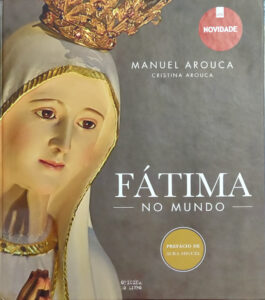 (Em conversa com Cristina Arouca, em 2012)
(Em conversa com Cristina Arouca, em 2012)
Ver:
Fátima no Mundo, de Manuel Arouca e Cristina Arouca Editora Ofício do Livro, 2016) https://www.amazon.com/F%C3%A1tima-Mundo-Portuguese-Manuel-Arouca/dp/9897414320) Fátima e o Mundo, documentário, Ep. 611, Dezembro de 2016: Fátima e a Ásia e a Oceânia. https://www.rtp.pt/play/p2909/e263645/fatima-e-o-mundo
Pastor's Day Musings
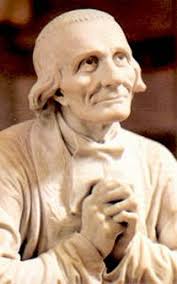
Curiously, despite the passage of years, the idea of a Priest that first pops up in my mind is the very same one that I gathered from my father half a century ago. In those days, parents and children spent quality time together, talking earnestly about real issues, religion at the head. My father made it a point to convey his idea on how a priest should be viewed: it was obviously an upshot of his long experience with priests amidst family and friends.
Papa didn’t discuss the universal priest; he had in mind products of Rachol seminary, many of whom he knew personally. In his recent book, Goa tal como a conheci (Goa as I knew it), published posthumously, he refers to that institution as “an excellent ornament of our archdiocese”, “an institution of such noble traditions” that produced “priests of high intellectual and spiritual merit.” He states that a large number of those cultured and virtuous priests exercised their office in Goa and in mission stations; some of them were philosophers and theologians, journalists and writers, sacred orators, canonists and moralists, teachers and public men; some others, men of edifying piety or sanctity acknowledged by the people and the Church…”
One of Papa’s favourite anecdotes was about Dom José da Costa Nunes, who held Goa in high esteem, especially for her historical and cultural past. One day, the redoubtable Patriarch of the East Indies said in a private conversation: “Goa’s clergy are cultured and pious… Here, even an obscure parish priest from the New Conquests, for example, comes forth to discuss with the Patriarch, citing, if need be, an encyclical by Pope Paul III!..”
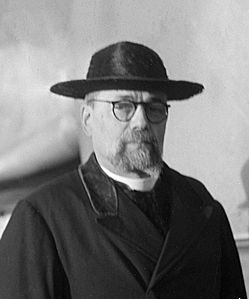
It goes without saying that Papa was in awe of the greatest Goan exemplars of sanctity – Joseph Vaz and Agnelo de Souza – and, what is more, imagined the clergy of his day to be inching forward in the Saints’ footsteps. I guess that in the evening of his life he’d begun to sense that this was not in sight; yet, he yearned for a quick and distinct change of tide. Usually, his portrayal of a priest would close with the words: “um santo padre” (a holy priest). That was a finale we could easily anticipate.
Looking back, I would say that Papa protected his children from the knowledge of any unedifying behaviour from pastors. When confronted with information that we children had gathered, he would make little of it. And Mama would second his opinion, by saying: “Quem sabe!” – Who knows! Once it was about a Jesuit whom he held in esteem for his intellectual prowess, and presuming that his spiritual life was on par. I seized the opportunity and sought to know how Papa bore such an exalted idea of every priest. He said, quite simply: “We’ve always seen priests in a good light. By and large, our priests have been above reproach.”
 Papa had a definite opinion on the apologetics and polemics of his times. His very own priest uncles, Castilho and Elínio, had been in that league. At the dinner table, he sometimes recounted stories of the journalistic antics of anti-Catholic, Portuguese republicans of the early twentieth century and how a good number of Catholic priests and laymen had combated them. However, Papa’s musings in his book end on a plaintive note: “With Vatican Council II, polemics was replaced by dialogue between religions and cultures. And with this new way of looking at things, the old type of Catholic apologist or polemist quietly faded away.”
Papa had a definite opinion on the apologetics and polemics of his times. His very own priest uncles, Castilho and Elínio, had been in that league. At the dinner table, he sometimes recounted stories of the journalistic antics of anti-Catholic, Portuguese republicans of the early twentieth century and how a good number of Catholic priests and laymen had combated them. However, Papa’s musings in his book end on a plaintive note: “With Vatican Council II, polemics was replaced by dialogue between religions and cultures. And with this new way of looking at things, the old type of Catholic apologist or polemist quietly faded away.”
And how do I end my musings on Pastor’s Day 2019? I wish our priests many fulfilling years in the Vineyard of the Lord… My children’s father may be unable to exert the same influence as did their grandfather… Let it be. Much water has flowed under the Mandovi Bridge since the days when we would sit together and ponder… After all these years all I wish, with teary saudade, is to see the vindication of the essential parts of my father’s image of the Pastor.
(Renovação, 1-15 Sept 2019, p. 14)
Blessed by the Star
It is common for Catholics in India to assume that Independence Day was timed to coincide with the Feast of the Assumption of the Blessed Virgin Mary into Heaven. This is simply not true. Whereas the state of India was released from British rule on 15 August 1947, the ancient Marian belief was dogmatically defined three years later, on 1 November 1950. Read more
